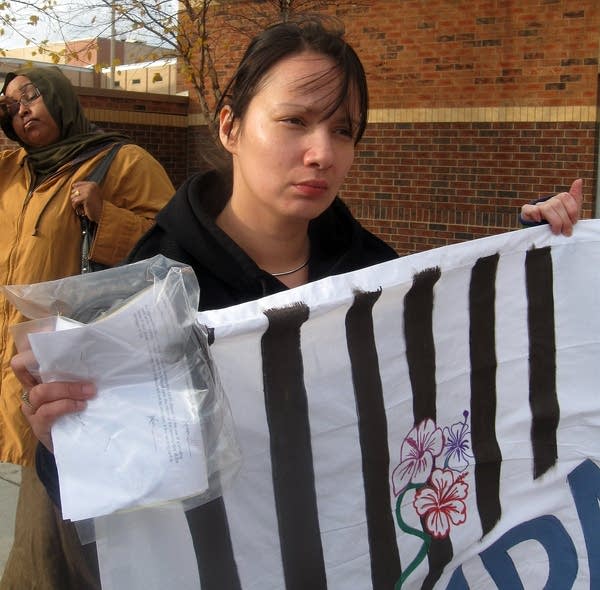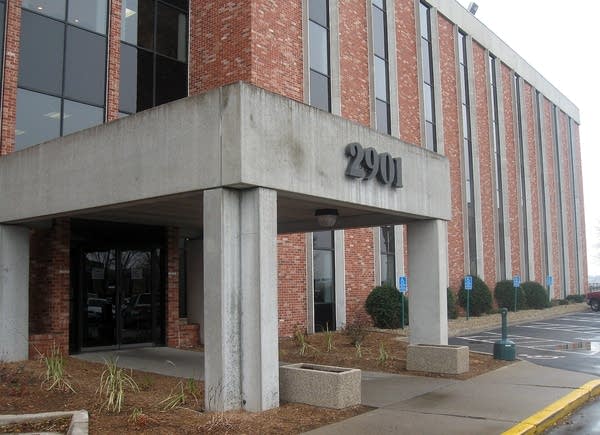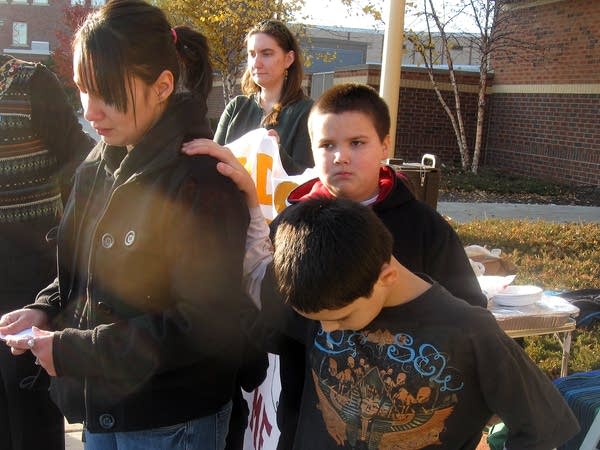Immigrant detention grows in Minnesota

According to Immigration and Customs Enforcement, 8,000 people in Minnesota are in deportation proceedings. Right now, 200 to 300 are in custody, housed in one of five county jails where ICE rents bed space, and detainees can spend months locked up. Most people who are deported have no criminal record.
The Obama Administration says the current system of incarcerating detainees isn't working. It plans to build a new system specially designed for immigrant detainees, but that will take years.
You can listen to two-part audio version of this story by using the links on the side of the page.
Create a More Connected Minnesota
MPR News is your trusted resource for the news you need. With your support, MPR News brings accessible, courageous journalism and authentic conversation to everyone - free of paywalls and barriers. Your gift makes a difference.
Most Restrictive
In Minnesota, ICE rents bed space in five county jails: Sherburne, Carver, Nobles, Freeborn and Ramsey. On any given night, 50 to 70 detainees can be found in the Ramsey County Jail in downtown St. Paul.
Mary Baquero is an immigration attorney in private practice in Richfield. On a recent Saturday evening, she and her husband, Richard Baquero, visited the Ramsey County Jail to see three of their clients.
"I think out of all the jails we come to, this is the most restrictive on their freedom," Baquero said.
Earlier that day, the Baqueros were at Sherburne County Jail, visiting another detained client. At Sherburne, Baquero noted there's an outdoor yard; detainees at Ramsey never see the sun.
ICE detainees spend an average of 100 days at Ramsey.
ICE's priority is deporting criminals. According to ICE, 60 percent of the people detained in Ramsey have some kind of criminal record. The other 40 percent are locked up because ICE considers them a flight risk.

The duty guard wouldn't allow a journalist to observe the Baqueros' meeting their clients.
"I wish you would have been able to come back to see it," said Mary Baquero when she returned to the jail lobby. "They keep it very cold. So when you shake their hand, it just jolts you. It's freezing. It's like they're outside."
"It's like touching a tombstone," Richard Baquero said. "It's exactly the same feeling."
According to Holli Drinkwine, the public information officer for the Ramsey County Sheriff's office, the jail's thermostat is parked at 68 degrees day and night. "One person's 'hot' is another person's 'cold,'" Drinkwine said.
Overhauling Detention

David Venturella is the Acting Director for the Office of Detention and Removal Operations within ICE in Washington D.C. He's runs this whole system for the Obama Administration and he said the Ramsey Jail has a good rating from ICE, but the larger issue is that jails aren't the right place to house detainees.
"The big difference is they're not being held for a crime, they're not being held to be rehabilitated and it's not for punishment. So those three right off bat distinguish the type of detention environment that we have," Venturella said. "Our challenge it to continue to foster a civil detention environment, and probably migrating away from some of these traditional facilities, developing our own facilities or contracting for facilities that can accommodate these unique populations."
Venturella described the detainee population as substantially different from a general jail population. Among immigrant detainees, there are more women, a wider range of nationalities and unique mental health and medical issues. The new detention plan calls for less restrictive environments that would allow detainees better access to legal information, their families and attorneys.
The federal government estimates it will take three to five years to overhaul the detention system. Venturella said the number of detainees housed every night in the United States --which currently stands at 32,000 -- is not expected to go down.
Prayers Outside the Jail
On the first Sunday of each month, the Interfaith Coalition on Immigration holds what it calls a "faith action" outside the Ramsey County Jail.

On November 1, the group observed "The Day of the Dead" with an altar on the sidewalk in front of the jail and Aztec dancers performing in the parking lot.
They read the names of 100 people who have died in detention nationally since October 2003. One death happened in Ramsey in 2006, when an Ecuadorian woman died of an undiagnosed and untreated brain infection.
ICE now has voluntary detention standards in place that detail the kind of care detainees are to receive, but they have no force of law.
Loren McGrail is a United Church of Christ minister and one of the lead organizers of the Interfaith Coalition on Immigration. McGrail hasn't had any contact with the detainees inside.
Her group is negotiating with Ramsey County Sheriff Bob Fletcher to allow pastoral visits in person, not through glass or a videoconference. ICE says detainees are entitled to pastoral care. Fletcher declined to be interviewed for this story.

One practical result of these monthly vigils is to extend support to family members of detainees. As wives, sisters and children finished their 20-minute Sunday videoconference visits with family members inside, they drifted out to the small crowd in front of the jail. Soon they joined in, reading the names of detainees who died.
Family members also gave McGrail some clues about how the detainees were doing inside: who was sick, who was cold and who was lost.
Pressing for Answers
As the faith action wrapped up, McGrail scooped up a basket of rolls and a cup of hot chocolate and carried them inside for the guards. McGrail keeps the guards in her prayers. She wants them to be kind and do their jobs with compassion.
The young guard in the glass booth politely declined her offer.

McGrail leaned into the glass and gently pressed him about what she had learned outside that day. There were more complaints about the temperature inside, and one family said their sister was sick and couldn't see a doctor because she didn't have money in her account for a co-payment.
McGrail questioned why she needed to make a co-payment since detainee medical care is covered by the Department of Homeland Security. The guard confirmed she didn't need to pay. Then he corrected himself. "There is $5.00 co-pay," he said.
"Maybe it's different for immigration," he shrugged.
"It is." McGrail said. The guard said he wasn't sure.
This is the heart of the problem for ICE. Detainees are subject to different rules -- in this case, their health care is completely covered. But it's confusing for guards used to dealing with the regular jail population living under different rules.
A recent study by the Humphrey Institute found 90 percent of local immigration attorneys surveyed reported clients who had problems obtaining medical care they needed while in detention. The report cited a lack of interpreters, prohibitively expensive phone cards, attorneys spending half their time driving to far-off detention facilities, and a lack of transparency in ICE meeting its own voluntary standards for detention.
Reluctant Business
In 2006, Raphael Ortega, a Ramsey County commissioner with oversight over the jail asked the county board to stop housing ICE detainees. Sheriff Fletcher, who runs the jail, supported him in this. The men said the jail was not an appropriate place to hold civil detainees for months on end.

"Quite frankly, I raised the question about whether we should we continue providing this housing of these individuals," Ortega said. "It was a close vote. I think it was 4-3 and the policy or the vote was to maintain the current existent agreement with ICE."
ICE pays the jail $80 per night to house a detainee and the county earns $1.8 million per year housing them.
No one is happy. The Obama administration concedes it's a problem to house civil detainees in jails but that's not going to change anytime soon.
Ramsey County's Rafael Ortega doesn't like the risk of housing people for months at a time in a facility never designed for long-term stays. For now, ICE is paying the bills in a tough economy.
Unhappiest of all, are the detainees on the inside.
Inside the Jail

The world of immigrant detainees is almost impossible to penetrate from the outside. It's tricky to find out where people are being held. Detainees do not have the right to an attorney and they can be shuffled from one facility to another and whisked out of state without a goodbye to their families.
ICE granted MPR permission to interview a detainee David Soto, who's being held in Ramsey, in person. His own mother wouldn't be able to do this. She'd have to talk with him via videoconference. That's the only way families can visit here.
Soto, 23, is originally from Mexico. At the time of the interview, he'd been held for 37 days. ICE raided his family's home in Burnsville in mid-October, and he ended up spending 18 hours a day in his cell.
"Most of us are all immigrants," Soto said. "We're all immigrants, but in my opinion, in their eyes, we're all still 'criminals.'"
Soto estimated the 60 men in his cell block were nearly all detainees like himself. His cellmate was an older man from Ethiopia.
For three hours in the morning and three hours in the afternoon, the detainees were allowed to socialize in a common area with tables and vending machines. There's no outdoor yard.
"I haven't seen the sun except on the trip here and on the trip out to court," Soto said. "That's the only time I've seen outside since I've been here."
David Soto writes about what it's like in detention. Read his commentary.
Shackled in Court

The trip to court happened the day before the interview. Soto and his older brother, Jorge Soto, who's also locked up in Ramsey, were brought in to see the immigration judge for a bond-redetermination hearing. The brothers shuffled in wearing bright orange jumpsuits, leg shackles over their jail socks and flip-flops, and handcuffs.
They have slight builds and stand about 5 feet 5 inches tall. They both wear glasses and their heads swiveled around the small, windowless courtroom of the ICE detention court. They looked scared.
The brothers had been looking forward to their day in court. When they were told in the morning to prepare for court, they were put in a holding cell and waited for several hours for the ICE agents to show up.
"I just hear chains because they bring up bags of chains, the shackles and handcuffs," Soto said. "It's just a little demeaning I believe, because where are we going to run? We're already in here."
The Carrot Suit
On the day of the interview, David Soto is more relaxed. He's not shackled or handcuffed. He makes a joke about his appearance.
"The carrot suit I call it," he said with a small laugh. "And they give us flip-flops and orange socks. So that's what I'm wearing. That's the fashion here."
Soto has no criminal record. He said this is the first and the last time he'll ever be in jail. He didn't expect things to turn out this way.
Waking up in California
David Soto came to America with his parents when he was 6 and his older brother, Jorge, was 10. David remembers he slept when they crossed the border and he woke up in California.
He started kindergarten there and the family moved to Northfield when he was in the middle of 3rd grade. His parents worked factory jobs. His father got some bad legal advice and applied for asylum when they came to the U.S.; there is no asylum from Mexico. The government mailed the family a deportation letter in California, but they never got it. They were living in Minnesota by then.
Since the family has been ordered deported once, the brothers have to be locked up while their attorney tries to re-open their case. Their father has already been deported for a crime the family said he didn't commit.
Their mother will likely be put on an electronic ankle bracelet so she can be home with her youngest son, a 16-year old who's an American citizen. Soto said he feels bad for what his mother is going through. She's trying to come up with $12,000 to post bond to free her boys.
"That's a lot of money that they're asking for us," he said. It's difficult for some of the lowest wage workers in this economy to find that kind of cash.
"My mom's out there begging, trying to borrow the money, working hard so me and my brother can get out," he said. "His mother works as a Mary Kay Lady. Soto said she's good at it, but he knows it's been hard for her lately to liven people up and make the sale because she's depressed by her family's troubles.
Soto said jail wears people down. He and his brother were encouraged by ICE to sign their own deportation orders the day they were brought in, and waive their right to see an immigration judge. Many do, but David and his brother said "no." They are also rare in that the family has hired an immigration attorney, Mary Baquero. Unlike criminal law, detainees have no right to an attorney.
Soto said he's holding up OK in jail because his older brother is with him, though they're locked on different floors.
Early on, he asked a guard if he could move downstairs so he could be closer to his older brother. He learned from the guard that family members are not even supposed to be housed in the same unit.
"I wasn't going to argue, I didn't want to get in trouble," said Soto. "You can't really speak up because you'll get in trouble. You'll get locked in for 23 hours." Soto's fluency in English and talkative nature helped him as a volunteer interpreter in the jail, but he didn't want to get labeled as a trouble-maker.
"There was a lot of times I wanted to speak up on behalf of myself, on behalf of other inmates, but I kept my mouth shut because I thought it was the best for everybody," he said.
He figures the guards were nice enough to keep him in the same section of the jail, even after learning that the men were brothers. They are seldom able to talk because when one floor is out in the common area, the other floor is locked down in their cells, and vice versa. But they can keep an eye out for each other. "I can see him when I look through my window," said Soto. "He can look up and see me saying 'hi'."
"I didn't picture it happening like this"
Soto said he knew his family needed to fix their legal status and this wasn't the way he pictured it happening. He thought they could go to an attorney to explain all the years they've been here, working hard and paying taxes. Soto graduated from Farmington High School and said he's eight credits short of completing his degree in graphic design from Dakota County Technical College. He was putting himself through school by working as an interpreter. As an illegal immigrant, he wasn't eligible for financial aid.
But for Soto, who has neither a U.S. citizen spouse, parent or child, there is no relief from deportation. His only hope is if his mother can petition to become a citizen because she is the mother of a U.S. citizen child, his youngest brother. Then, in turn, she could petition for him.
So Soto found himself translating for other immigrants in jail. He estimates 80 to 90 percent are Spanish speaking, and not all of them can read the instructions posted at the jail about how to request documents needed for their immigration cases.
As for the conditions in the jail, Soto doesn't complain. He received medical care the one time he asked for it. A dentist treated him for a toothache. He said the food is OK, but he often wishes he could have seconds.
He buys Ramen noodles at four times their retail price from a vending machine to fill himself up. He said at night it's cold in the jail and he covers his head with a thin blanket to block the draft and the lights that are always on. Thoughts race through his head.
"I'm looking forward to getting out of here and getting my life back," he said. "You know, we lost everything we had. It had to happen sometime. We had to face the situation of us being here illegally, you know eventually. I knew it had to come. We couldn't be here forever like this. I just didn't expect it to come like that."
Despite the raid, the time in jail and what could be a year-long legal battle, Soto said America is still the country he wants to live in. If he's deported, he said he'll have to accept it.
Temporary Freedom
Four days after David Soto was interviewed by MPR, his mother posted the $12,000 bond to free her two oldest sons. David and Jorge are put on electronic ankle bracelets while they continue to fight their case from the outside. Their attorney has warned them only 12 percent of the people who fight deportation win.
Over at the courthouse, Soto shyly shows off a souvenir from his five-week stay in jail. The ICE raid had happened so quickly, Soto was taken into custody without socks. Today, he's back in his own shoes. He slides up his pant leg to reveal the bright orange socks from jail. A black ankle bracelet is locked to his calf. It's freedom, at least, for the moment.
